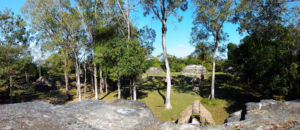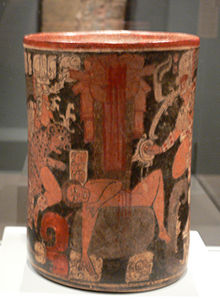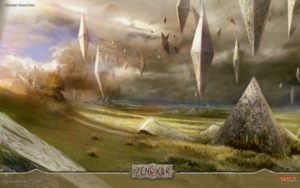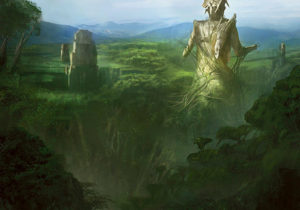In this week’s Uncharted Realms, Nissa loses her innate connection to Zendikar, and with it her control of Ashaya, her elemental companion, after battling Eldrazi across her plane. Although she reaches Sea Gate and joins with Gideon and his allies, the disconnect from the natural power of Zendikar bodes ill for the plane as it faces annihilation by the Eldrazi monsters and their attendant corruption.
This article continues last week’s exploration of themes and parallels that are echoed between the jungle plane of Zendikar and the Yucatan civilization of the Mayan peoples. While the previous Planeswalker’s Guide to Earth focused on landscape, this week looks at culture and history between the plane of Zendikar in Magic’s multiverse and our own world.
Ancient Architecture and Artifice
A common theme to both Mayan civilization as examined through historical study and the plane of Zendikar is the presence of monumental architecture whose past and purpose remains a mystery (at least, until the irruption of the Eldrazi). The hedron stones which dot the lands, sky, and seas of Zendikar are a puzzle to extraplanar visitors and native denizens alike, and only the disaster of the Eldrazi’s emergence sheds light upon their intended purpose. Mayan temple architecture, like the hedrons, conforms to an ancient logic which is still being discovered today.
The Maya, before and after the societal upheaval of the 9th century CE, were keen observers of the cosmos and the movement of heavenly bodies. Astrology was the core of Mayan sacred divination, and closely tied to the civilization’s mathematical discoveries and temple construction. Mayan temples are found to adhere to a model called an “E-Group,” first uncovered by archaeologists at Uaxacatun, with temple structures aligned at the north, south, and center of the religious complex. This precise layout of religious architecture has only recently been discovered to correspond to the location of the sunrise at moments of astrological importance – the winter solstice, the summer solstice, and the seasonal equinoxes.

“Uaxactun Group E from Temple Of Masks” by David Germain – own work. Licensed under CC BY 3.0 via Commons.
Beyond these massive efforts of religious architecture, other Mayan construction adhered to observation of astrological phenomena. The windows of Caracol at Chichen Itza mark the progress of Venus across the heavens, and the obelisks at Copan observe the setting sun on the eve of the equinox. Like the hedrons of Zendikar, the ruins of Mayan architecture are evidence of ancient belief and power, mysterious to modern observers but built for vital purposes to the historical peoples of the Yucatan.
Sacrifice
Alongside the astrological augury which informed the construction of the magnificent Mayan temple complexes, their daily function in worship and ceremony is echoed in the darker aspects of Zendikar’s cultural landscape. Like many religious societies throughout the ancient world, Mayan faith involved ritual sacrifice, with a religious focus upon bloodletting that would not be completely unknown to the vampiric ruling class of Zendikar’s Guul Draz marshes.
In times of great calamity or portent, the greatest offering of all – blood, the essence of human life – could be made to forestall disaster and renew a compact with the gods.
Sacrifice in Mayan religious ceremony took many forms. Like much of their intercession to the realm of the spirits, the Mayan peoples placed tremendous emphasis upon the precision of their worship, calculating the exact tribute owed to their gods on days of astrological auspice or times of great need. The observation of the new year, precisely recorded by the lunar calendar, required a ritual gift of exactly 415 grains of corn (maize) to each participant, for example.1 There was thus a formula for all intercessions to the realm of the divine, undertaken at specific points in the year. Yet even this regimented worship was sometimes not enough.

“Maya vessel with sacrificial scene DMA 2005-26” by Photo: User:FA2010 – Own work. Licensed under Public Domain via Commons.
In times of great calamity or portent, the greatest offering of all – blood, the essence of human life – could be made to forestall disaster and renew a compact with the gods. The Mayan gods were thought to derive nourishment from human blood, and so sacrifice of this type took various forms. Nobles and clergy occasionally made vital offerings in the form of bloodletting onto strips of paper, which were burned in ritual pyres.
This symbolic gift was sometimes insufficient, however, and in such cases human life was needed as a sacrifice to the gods. Captured nobles were ritually decapitated or had their hearts torn out to secure victory in times of war, while in peacetime other prisoners were disemboweled or thrown into the vital cenote sinkholes to secure release from drought and plague. Blood as nourishment – with attendant sacrifice – defines the vampiric societies of Zendikar and the ancient religion of the Mayan peoples alike.
Buried Treasure
Finally, the Mayan Yucatan and the plane of Zendikar share a common theme of buried treasure and mystery due to a shared past of destructive conquest. With the arrival of Spanish sailors in 1511 CE and the armies of conquistadores from 1526 CE, the Mayan people faced nothing less than the total annihilation of their religion and culture in the face of forcible conversion. The astronomy and sacrifice which characterized Mayan (and northward Aztec) religion were anathema to Catholic clergy and civil administrators, and so a concerted effort was made to destroy nearly all record of Mayan faith and its accomplishments in astronomy, mathematics, and art. Of the few sources of Mayan written culture that survive, most are 16th century Spanish records of a faith they sought to displace.
But the Yucatan was a terrain unlike the rest of Aztec Mexico to the north. Densely forested and only habitable around the sacred cenote sinkholes, the heartland of Mayan civilization was not easily conquered by outsiders unfamiliar with the territory. Furthermore, in the wake of the 9th century collapse, the Maya were a confederation of loosely affiliated city-states rather than a centralized empire like the Aztec in Tenochtitlan (modern-day Mexico City).2 While this prevented the formation of a united front in the face of Spanish aggression, it also forestalled conquest thanks to the lack of a single central authority to be captured.
Densely forested and only habitable around the sacred cenote sinkholes, the heartland of Mayan civilization was not easily conquered by outsiders unfamiliar with the territory.
Even decades after the initial invasions of 1526 and 1542 CE, Mayan settlements in the deep interior of the Yucatan resisted Spanish colonization. Only the belief that golden treasures like the fabled city of El Dorado lay deep in the merciless jungle continued to motivate adventurers, most of whom (like the initial Montejo expedition in 1526) returned with little more than dwindled ranks. Every year, new discoveries about the ancient Mayan peoples are made, and a connection to a great civilization is renewed by further sites yielded by the great jungle. Nissa’s connection to Ashaya and her plane of Zendikar is no less a treasure and gift, despite the violence that inhibits her bond and clouds so much of our own history here on Earth.
1 Alfred M. Tozzer, A Comparative Study of the Mayas and the Lacandones. Archaeological Institute of America. The Macmillan Company, New York 1907.
2 Clendinnen, Inga. Ambivalent Conquests. New York, NY: Cambridge University Press, 1987



